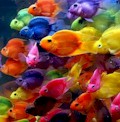An aquarium plural aquariums or aquaria is a vivarium consisting of at least one transparent side in which water-dwelling plants or animals are kept. Fish keepers use aquaria to keep fish, invertebrates, amphibians, marine mammals, and aquatic plants. The term combines the Latin root aqua, meaning water, with the suffix -arium, meaning "a place for relating to".
An aquarist owns or maintains an aquarium. Aquaria can come in a variety of materials, shapes, and sizes. They are typically constructed of glass or high-strength plastic. Cuboid aquaria are also known as fish tanks or simply tanks, while bowl-shaped aquaria are also known as fish bowls. Size can range from a small glass bowl to immense public aquaria. A number of components are used to maintain appropriate water quality and characteristics suitable for the aquarium's residents. Organisms maintained or type of environment mimicked classify many aquaria.
History and Popularization of Fish KeepingPeople have kept fish in artificial environments for centuries. In the Roman Empire, the first fish to be brought indoors was the sea barbel, which was kept under guest beds in small tanks made of marble. Introduction of glass panes around the year 50 allowed Romans to replace one wall of marble tanks, improving their view of the fish. In 1369, the Chinese Emperor, Hongwu, established a porcelain company that produced large porcelain tubs for maintaining goldfish. Over time, people produced tubs that approached the shape of modern fish bowls.
In 1836, soon after his invention of the Wardian case, Ward proposed to use his tanks for tropical animals, and in 1841 he did so, though only with aquatic plants and toy fish. However, he soon housed real animals. In 1838, Félix Dujardin noted owning a saltwater aquarium, though he did not use the term. In 1846, Anna Thynne maintained stony corals and seaweed for almost three years, and was credited as the creator of the first balanced marine aquarium in London. At about the same time, Robert Warington experimented with a 13-gallon container, which contained goldfish, eelgrass, and snails, creating one of the first stable aquaria; he published his findings in 1850 in the Chemical Society's journal. The keeping of fish in an aquarium became a popular hobby and spread quickly.
Aquarium DesignMost aquaria consist of simple glass panes bonded together with silicone. Usually plastic frames are attached to the upper and lower edges for decoration. Price, availably, and reliability make the glass aquarium an industry standard for sizes up to 250 gallons / 1000 liters. However glass is brittle and has very little give before fracturing though generally the sealant fails first. Aquaria come in a variety of shapes such as cuboids, hexagonal, angled to fit into a corner, bow front, and more. Fish bowls are generally either plastic or glass, either spherical or some other round configuration.
Acrylic aquaria are also available and are the primary competitor with glass. Acrylics are stronger than glass, and much lighter. Acrylic-soluble cements are used to directly fuse acrylic pieces together (as opposed to simply sealing the seam). Acrylic allows for the formation of unusual shapes, such as hexagons. Compared to glass, acrylics are easy to scratch and care must be taken with organisms with shells and teeth. Laminated glass might be used, which combines the advantage of both glass and acrylic.
Large aquaria might use stronger materials such as fiberglass-reinforced plastics. However, this material is not transparent. Reinforced concrete is used for aquaria where weight and space are not factors. Concrete must be coated with a waterproof layer to prevent the water from breaking down the concrete as well as from preventing contamination from the concrete.
